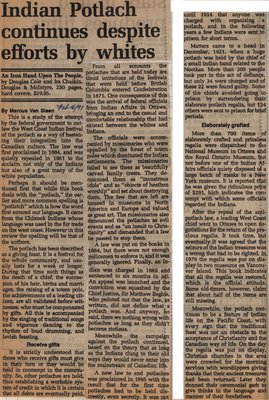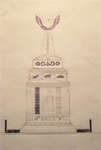"Indian Potlatch Continues Despite Efforts by Whites"
- Full Text
- Indian Potlach continues despite efforts by whitesBy Marcus Van Steen
This is a study of the attempt by the federal government to outlaw the West Coast Indian festival of the potlach as a way of hastening their integration into the Canadian culture. The law was first proclaimed in 1884, and was quietly repealed in 1951 to the acclaim not only of the Indians but also of a great many of the white population.
Perhaps it should be mentioned first that while this book deals with the "potlach," the earlier and more common spelling is "potlatch" which is how the word first entered our language. It came from the Chinook Indians whose language was used in the fur trade on the west coast. However in this review the spelling will be that of the authors.
The potlach has been described as a giving feast. It is a festival for the whole community, and usually lasts for a week or longer. During that time such things as the death of a chief, the succession of his heir, births and marriages, the raising of a totem pole, the achievements of a leading citizen, are all validated before witnesses, who must be compensated by gifts. All this is accompanied by the singing of traditional songs and vigorous dancing to the rhythm of loud drumming, and lavish feasting.
Receive giftsIt is strictly understood that those who receive gifts must give in their turn or they would be held in contempt in the community. So, other potlaches are held, thus establishing a workable system of credit in which it is certain that all debts are eventually paid.
From all accounts the potlaches that are held today are timid imitations of the festivals that were held before British Columbia entered Confederation in 1871. One consequence of this was the arrival of federal officials from Indian Affairs in Ottawa, bringing an end to the casual and comfortable relationship that had existed between the whites and Indians.
The officials were accompanied by missionaries who were appalled by the forest of totem poles which dominated the Indian settlements. The missionaries failed to see these as beautifully carved family crests. They denounced them as "monstrous idols" and as "objects of heathen worship" and set about destroying them. The few that are left are housed in museums in North America and Europe are valued as great art. The missionaries also denounced the potlaches as evil events and as "an insult to Christianity" and demanded that a law be passed to stop them.
A law was put on the books in 1884, but there were not enough policemen to enforce it, and it was generally ignored. Finally, an Indian was charged in 1889 and sentenced to six months in jail. An appeal was launched and the conviction was squashed by the Chief Justice, Sir Matthew Begbie, who pointed out that the law, as written, did not define what a potlach was. And anyway, he said, there ws nothing wrong with potlaches as long as they didn't become riotious.
Meanwhile the campaign against the potlach continued, based on the theory that as long as the Indians clung to their old ways they would never enter into the mainstream of Canadian life.
A new law to end potlaches was proclaimed in 1895 with the result that for the first time potlaches had to be held discreetly, even secretly. It was not until 1914 that anyone was charged with organizing a potlach, and in the following years a few Indians were sent to prison for short terms.
Matters came to a head in December, 1921, when a huge potlach was held by the chief of a small Indian band related to the Nootkas. More than 300 people took part in this act of defiance, but only 34 were charged and of these 22 were found guilty. Some of the chiefs avoided going to prison by surrendering their elaborate potlach regalia, but 134 others were sent to prison for brief periods.
Elaborately graftedMore than 700 items of elaborately crafted and priceless regalia were dispatched to the National Museum in Ottawa and the Royal Ontario Museum, but not before one of the Indian Affairs officials quietly disposed of a large batch of masks to a New York museum. It is reported that he was given the ridiculous price of $291, hich indicates the contempt with which some officials regarded the Indians.
After the repeal of the anti-potlach law, a leading West Coast chief went to Ottawa to open negotiations for the return of the precious regalia. It took time, but eventually it was agreed that the seizure of the Indian treasures was a wrong that had to be righted. In 1979 the regalia was put on display in two museums on Vancouver Island. This book indicates that all the regalia was restored, which is the official attitude. Some old-timers, however, claim that about half of the items are still missing.
Meanwhile, the potlach continues to be a feature of Indian life on the Pacific Coast, with every sign that the traditional feast was not an obstacle to the acceptance of Christianity and the Canadian way of life. On the day the regalia was put on display, Christian churches in the area were crowded for the morning services with worshippers giving thanks that their ancient treasures had been returned. Later they donned their ceremonial garb to give thinks in the language and manner of their forefathers.
- Creator
- Van Steen, Marcus, Author
- Media Type
- Newspaper
- Item Types
- Articles
- Clippings
- Description
- "This is a study of the attempt by the federal government to outlaw the West Coast Indian festival of the potlach as a way of hastening their integration into Canadian culture."
- Date of Publication
- 16 Feb 1991
- Subject(s)
- Corporate Name(s)
- National Museum ; Royal Ontario Museum.
- Local identifier
- SNPL002858v00d
- Language of Item
- English
- Creative Commons licence
 [more details]
[more details]- Copyright Statement
- Public domain: Copyright has expired according to Canadian law. No restrictions on use.
- Copyright Date
- 1991
- Contact
- Six Nations Public LibraryEmail:info@snpl.ca
Website:
Agency street/mail address:1679 Chiefswood Rd
PO Box 149
Ohsweken, ON N0A 1M0
519-445-2954



